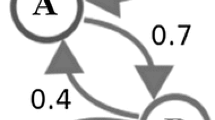Abstract
We put forward a chaotic estimating model, by using the parameter of the chaotic system, sensitivity of the parameter to inching and control the disturbance of the system, and estimated the parameter of the model by using the best update option. In the end, we forecast the intending series value in its mutually space. The example shows that it can increase the precision in the estimated process by selecting the best model steps. It not only conquer the abuse of using detention inlay technology alone, but also decrease blindness of using forecast error to decide the input model directly, and the result of it is better than the method of statistics and other series means.
Similar content being viewed by others
References
Ott E, Grebogi C, Yorke J A. Controlling Chaos.Physical Review Letters, 1990,64(11): 1196–1199.
Cao Liang-yue, Hong Yi-guang, Fang Hai-ping,et al. Predicting Chaotic Time Series with Wavelet Networks. New York: IEEE Press, 1998. 231–236.
Martin C. Nonlinear Prediction of Chaotic Time Series.Phys D, 1989,35(7): 335–356.
Davies M E. Reconstructing Attractors from Filtered Time Series.Phys D, 1997,101(6): 195–206.
Gary M G, Nabeel B A, Mark S. Recurrence Matrices and the Preservation of Dynamical Properties.Phys Lett A, 1997,237(12): 43–47.
Henry D I, Reggie B, Hames B K. Prediction in Chaotic Nonlinear System: Methods for Time Series with Broadband Fourier Spectra.Phys Rev A, 1990,41(4): 1782–1807.
Cao Y J. A Nonlinear Adaptive Approach to Controlling Chaotic Oscillators.Phys Lett A, 2000,270: 171–176.
Tose A R, Hector P. Control of a Nonlinear System with Time-Delayed Dynamics.Phys Lett A, 1999,262: 166–173.
Li Dong-mei, Wang Zhen-gou. Small Parameter Perturbations Control Algorithm of Chaotic Systems Based on Predictive Control.Information and Control, 2003,32(5): 426–430.
Jiang Wei-jin. Non-Linear Chaos Time Series Prediction and Control Algorithm Based on NN.Journal of Nanjing University (Natural Sciences), 2002,38 (Computer Issue): 33–36.
Jiang Wei-jin. Research of Ware House Management Chaotic Control Based on Alterable.Micro Electronics & Computer, 2002,19(11): 55–57.
Chen L, Chen G R. Fuzzy Modeling, Prediction and Control of Uncertain Chaotic Systems Based on Time Series.IEEE Trans Circuits & Systems-I: Fundamental Theory & Applications, 2000,47(10): 1527–1531.
Taken F, Rand D A, Young L S. Detecting Strange Attractors in Turbulence.Dynamical Systems and Turbulence, Lecture Notes in Mathematics. Berlin: Springer-Verlag, 1980, 366–381.
Author information
Authors and Affiliations
Corresponding author
Additional information
Foundation item: Supported by the National Natural Science Foundation of China (60373062)
Biography: JIANG Wei-jin (1964-), male, Professor, research direction: intelligent compute and the theory methods of distributed data processing in complex system, and the theory of software.
Rights and permissions
About this article
Cite this article
Wei-jin, J., Yu-sheng, X. Research on optimize prediction model and algorithm about chaotic time series. Wuhan Univ. J. Nat. Sci. 9, 735–739 (2004). https://doi.org/10.1007/BF02831672
Received:
Issue Date:
DOI: https://doi.org/10.1007/BF02831672




